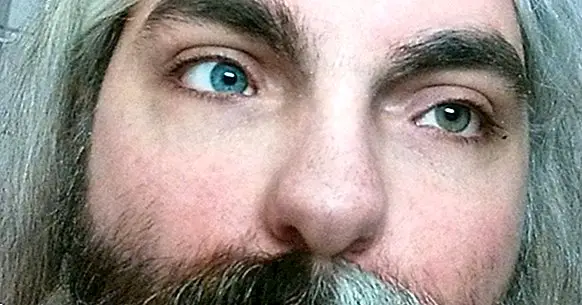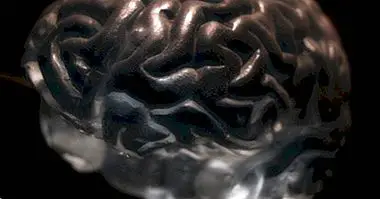Waardenburg syndrome: causes, symptoms and treatment
There are a lot of different alterations and conditions that can damage and harm our health. Many of them are highly known by most of the population, especially when they are relatively prevalent or dangerous. The flu, cancer, AIDS, diabetes or Alzheimer's are just some examples of this. Occasionally also some that are not taken into account by the majority of the population also jump to the forefront in the face of epidemics or awareness campaigns, such as Ebola, chronic obstructive pulmonary disease (COPD) or amyotrophic lateral sclerosis (ALS).
But there are many diseases that we have almost never heard of, such as those considered rare or a large number of genetic disorders. One of them is Waardenburg syndrome, which we will discuss along these lines .
- Related article: "The differences between syndrome, disorder and disease"
Waardenburg syndrome: main symptoms
Waardenburg syndrome is a strange disease of genetic origin , which is estimated to suffer one in forty thousand people and which is classified as within the neurocristopathies, disorders generated as a result of alterations in the development of the neural crest.
This disease is characterized by the presence of alterations in facial morphology , highlighting the presence of dystopia cantorum or displacement of the side of the inner canthus of the eye, pigmentation problems both at the level of skin and eyes that makes them have a clear coloration (it is not uncommon for eyes to have a characteristic intense blue or that heterochromia appears, and that part of the hair is white) and a certain level of hearing loss or even congenital deafness. It is not uncommon for vision problems to appear, although it is not one of the critical symptoms for diagnosis.
They can also appear other affectations linked to the digestive system, movement or even intellectual capacity . Also the hair can appear with gray hair or even with white strands, as well as light spots on the skin. Despite this, this syndrome is characterized by being highly heterogeneous, possessing different types of symptomatological presentation.
Types of Waardenburg syndrome
The Waardenburg syndrome, as we have said, does not have a unique way of presenting itself, but different subtypes of this syndrome can be distinguished. Among them the most prominent are four, being the first two most common (within rare diseases) and the second least frequent.
Waardenburg syndrome type 1
Waardenburg syndrome type 1 is one of the most common. In this type of presentation of the syndrome, all of the aforementioned symptoms are given: morphofacial alterations and pigmentation problems , together with a possible congenital deafness (although only occurs in about 1 in 4 cases) ..
The presence of one eye of each color or heterochromia is observed with great frequency , the clear tone of eyes (generally with tendency to blue) and skin and, one of the characteristic symptoms of this type, the presence of dystopia cantorum or displacement of the inner canthus of the eye. This type of symptom reminds hypertelorism, with the difference that in reality the distance between the eyes is not greater than the average (although in some cases hypertelorism may also appear).
Waardenburg syndrome type 2
Types 1 and 2 of Waardenburg syndrome share the diagnostic criteria almost entirely, with the symptoms practically identical. The main difference is in the fact that in type 2 no dystopia cantorum (If we do, we would have a type 1 Waardenburg syndrome).
In addition, in this presentation of the syndrome the facial morphological alterations are usually somewhat less marked than in comparison to type 1, while the deafness presented is usually more evident and frequent, being the majority (it appears in 70% of cases) . They may also get spina bifida or lack of genital development.
Klein-Waardenburg syndrome or type 3
This type of disorder is characterized by the fact that in addition to the above symptoms (it is generally closer to type 1), there are usually malformations in the upper extremities and alteration at the neurological level. Also, it is usually more correlated with problems of movement, muscular tension, cerebrospinal alterations or functional diversity at an intellectual level . It is also common for the eyelid to fall in at least one of the eyes, a symptom called ptosis, despite the absence of the dystopia cantorum.
Waardenburg-Shah syndrome or type 4
Very similar in symptomatology to Waardenburg syndrome type 2, but adding alterations in the enteric and gastrointestinal system that cause fewer neurons to manage the intestines and usually correlate with constipation and other digestive problems such as Hirschsprung's disease or congenital megacolon, in which feces are not expelled normally due to problems with the neuronal ganglia of the enteric system and there is an enlargement of the intestine and colon product of its obstruction.
Causes of this alteration
Waardenburg syndrome is a disease of genetic origin, which can be inherited or appear due to a de novo mutation . The heritability of this disorder depends on the type that we are analyzing.
Types 1 and 2 are transmitted by an autosomal dominant pattern. The problems seem to arise from a neuronal migration altered during the development, which generates the symptomatology and a lack of melanocytes (causing changes in pigmentation).
One of the genes that is most associated with the disorder in its most common types in types 1 and 3 is PAX3 (it is considered that 90% of type 1 have mutations in this gene). But he's not the only one. Type 2 is more associated with the MITF gene, and 4 is associated to an association of genes, including EDN3, EDNRB and SOX10.
- Maybe you're interested: "Types of intellectual disability (and characteristics)"
Treatment
Waardenburg syndrome is a genetic disorder, which does not at least at this time have any kind of curative treatment. However, many of the difficulties that the syndrome generates are treatable, taking place an approach that is more focused on symptoms and specific complications depending on the dysfunctionality or risk that may pose to the patient.
The most common type of intervention is the one that has to do with possible deafness or hearing loss, in which techniques such as the cochlear implant could be used . The monitoring and prevention of the appearance of tumors (for example melanomas) is also something to take into account and should they appear, they should also be conveniently treated. Some alterations of the skin and facial morphology may also require surgery, although it is not as frequent. Finally, if eye problems appear, they should also be treated.
In its majority the syndrome of Waardenburg does not generate nor usually it presents / displays great complications in its more common modalities, the type 1 and the type 2, so that those who suffer it can usually lead a typical life. This does not mean that they do not have difficulties, but in general the prognosis is positive in order to have a good quality of life.
In the case of subtypes 3 and 4, complications the number of complications may be higher. In the case of 4, the condition of megacolon can generate alterations that endanger the life of those who suffer from it . The latter is the case of megacolon, if it is not properly treated.
The treatment of these complications may require surgery to correct the megacolon or improve the functionality of the upper limbs (for example, reconstructing the extremities and separating the fingers). In case of intellectual disability, it may also be necessary to apply educational guidelines that take into account the possible problems derived from it, such as an individualized plan in the educational field (although usually the intellectual disability is usually mild).
Likewise, it is also necessary to assess the possible psychological affectation: the presence of morphological anomalies can trigger anxiety, self-esteem and depression problems derived from self-image. If necessary, psychological therapy can be very helpful.
Bibliographic references:
- Duque, G.A., Ramírez-Cheyne, J. & Saldarriaga-Gil, W. (2016). Waardenburg syndrome type 1 in monozygotic twins and their family. Journal of the Faculty of Medicine, 64 (2): 365-371.
- Santana, E.E. and Tamayo, V.J. (2015). Waardenburg syndrome, Presentation of an affected family. Medical Gazette of Espirituana, 17 (3). Cuba.
- Waardenburg, P.J. (1951). A new syndrome combining developmental anomalies of the eyelids, eyebrows and nose root with pigmentary of the iris and head hair and with congenital deafness. Amer. Jour. Hum. Genet., 3 (3): 195-201.



















